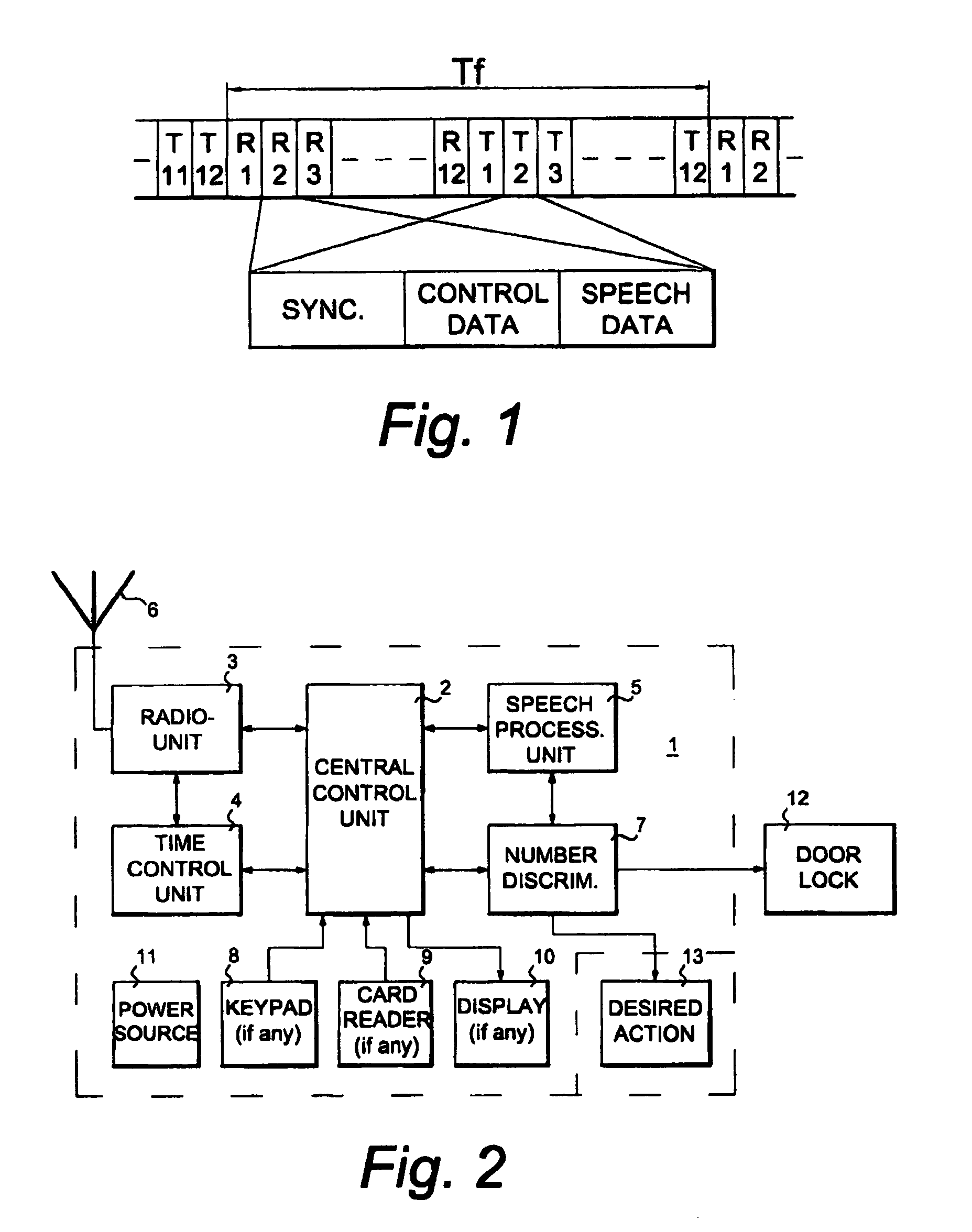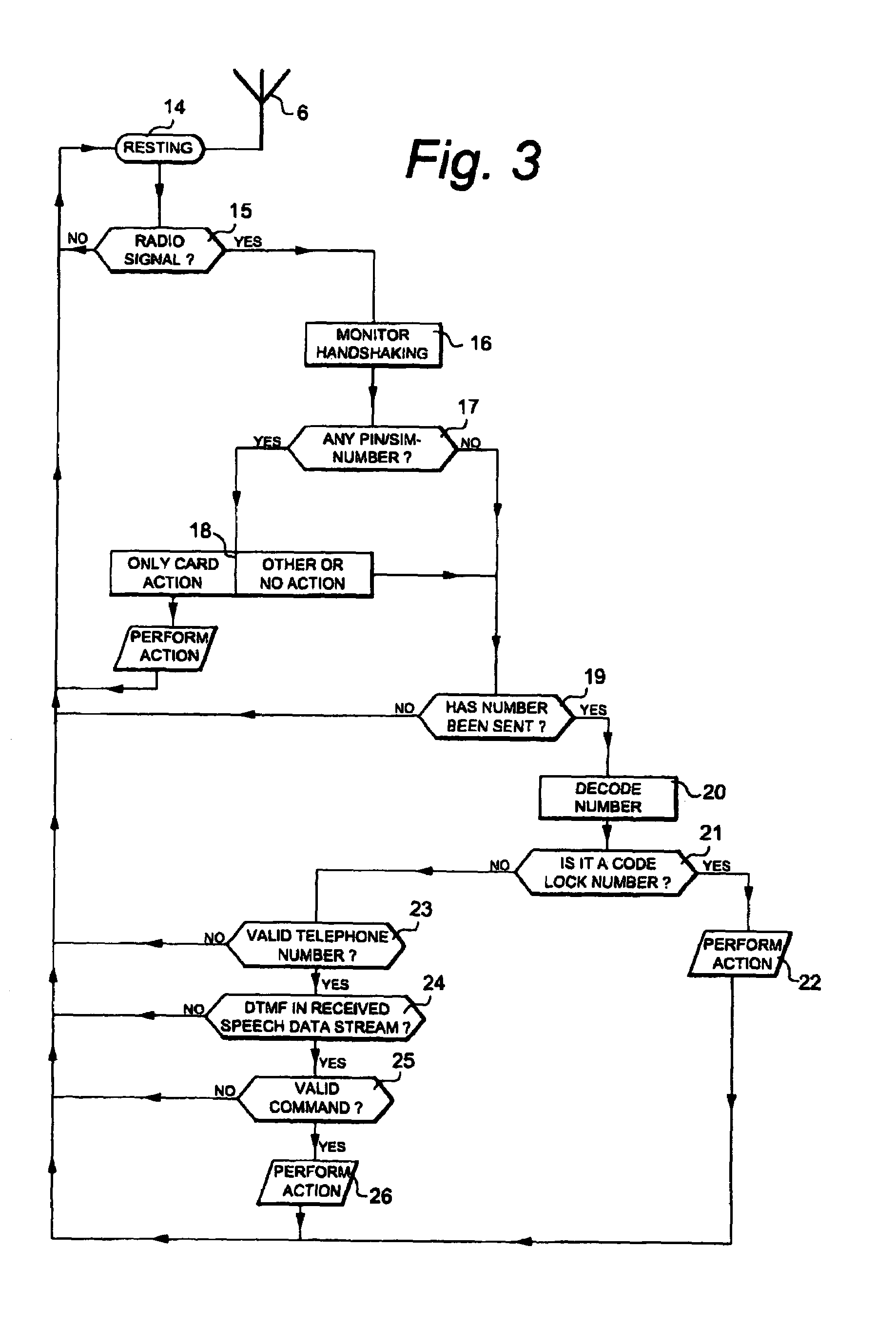[0006]It would be a major
advantage to accomplish an entrance
system, such as a door opening
system, which is easy to install and maintain, having good
sound quality, having a minimum of external physical user communication parts, which does not involve continuos fees for inhabitants and property owners for the use of the system etc., but instead allows a visitor's mobile telephone accomplish this. It is thus an object of the present invention to disclose a method and a device facilitating a
functional system having simple installation, substantially only requiring connection to an electrical power source and a controlled device, such as a door lock, but which does not require external physical user communication means such as a
microphone,
loudspeaker and push buttons / keyboard, as well as
wired communication circuits or connection to a communication network, but still offers complete and functional
selective control of visitors / entrance telephone services for intended building. A further object of the present invention is to give mobile telephones existing “out there” desired possibility for control of visitors / entrance telephone properties for a building having the aforementioned installation.
[0009]Since
mobile telephony is radio communication, same can be intercepted by devices known as scanners, which operate by continuously proceeding search of the
radio frequency spectrum or chosen parts thereof, and which detect and “lock” on active channels, and submit intercepted sound to a listener. In the case with analogue radio, the communication is immediately understandable, but with regard to digital communication, such as
GSM, the output would be a meaningless
noise, unless they are capable of performing a speech and signal data decoding operation with use of the same protocol as used for the intercepted signal. In the case of
GSM, such scanners are today commercially available, which are also capable of detecting the number dialled from the mobile telephone and also to disclose their individual and unique PIN (a subscriber's
personal identification number—“
International Mobile Subscriber Identity”—IMSI) / SIM number, particularly in the case when the mobile telephone is switched on from an off condition and when “
hand shaking” is performed with the
base station located closest to the subscriber with use of a few basic protocols, when also the protocols to be used for a subsequently following
telephone call are disclosed to an initiated listener. Accordingly, even though it is technically possible according to the present invention to perform required scanning / “tapping” of mobile telephones that are “switched on”. It is preferred and described that a visitor should initiate the
access control procedure by switching on a “disconnected” mobile telephone closely adjacent to the entrance to which access is desired. This results in many advantages.
[0010]Firstly, that the visitor's mobile telephone is located in such a
close relationship to the entrance as a normal entrance request situation requires, before same can be detected, prevents all other persons switching on their mobile telephones in an adjacent area from addressing or initiating the system according to the present invention. The antenna used by the system can thus be well screened, being directional and having a short reception range.
[0017]Non-existence of external physical user units (apart from the antenna, which can be arranged hidden) results in a highly secure substantially non-external installation, protected against external influence and damage, and expensive parts and covers are not required. Normally, only a few instructions are required (even though same may be an electronic display or similar, as well as audio / voice synthesized instructions, which on the other hand increases the costs and the risk for damage, but still remains as a possibility), and with indication of the area within which the mobile telephone should be switched on, even though this is not absolutely necessary for an experienced user, whereby nothing is required that would damage the looks, integrity and security of a beautifully designed entrance, even though same is equipped with an entrance surveillance system. Based on input of a correct
telephone number and that same is detected / approved by the number
discriminator, same can order connection of a TV camera operating on a channel in a cable TV system, and also via secondary unit give a general “alert” to all TV sets in the building, or based on the dialled number only to the party having said number, in order to disclose that the call resulting in a ring signal is an entrance
telephone call (should the called party have the service “caller ID”, the
telephone number / identity of the calling party is also disclosed) and that the visitor can be seen on TV, prior to responding to the call. A similar function can also be implemented for code / card addressing.
[0018]Certain mobile telephones use speech scrambling in order to make the calls
safer. Even so, all mobile telephones within a given area must use the protocols for
handshaking, dialled
telephone number,
radio transmission etc. This communication between the mobile telephone and the base
station remains within given standards. Only the speech is made subject to speech scrambling and can only be received by another telephone having the same
algorithm for speech scrambling. However, it is not a major problem to detect and decode DTMF signals from a scrambled
data stream. Since the pair of tones have such a typical configuration and maintain their frequency relationship also when scrambled, they are easily detectable as DTMF signals and their specific internal frequency relationship between the two frequencies identifies the digit.
 Login to View More
Login to View More  Login to View More
Login to View More 


